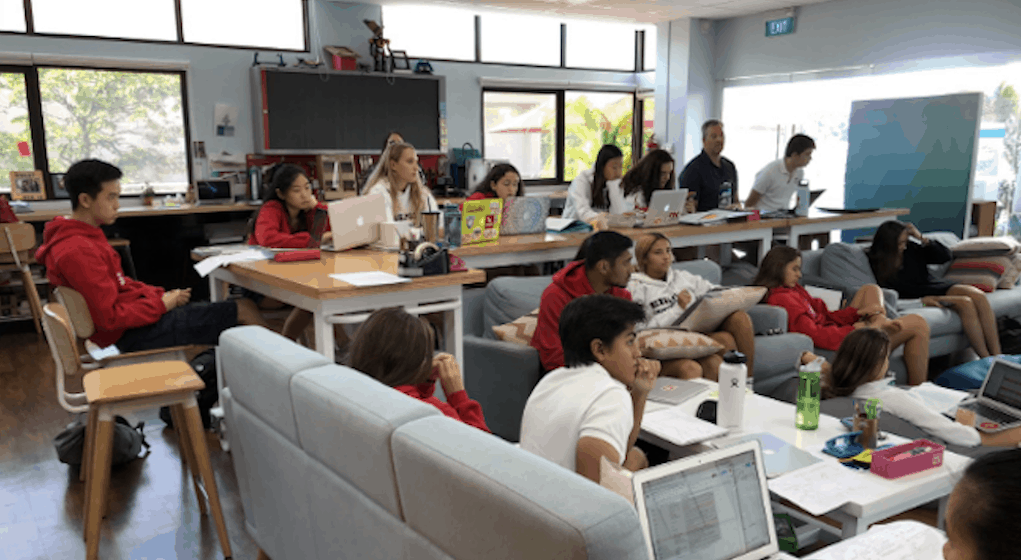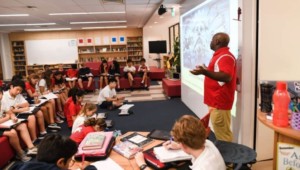Top Education Trend of 2018: Active Learning Spaces

The top learning trend in K-12 learning in 2018 was active learning spaces–from double classrooms in old buildings from California’s Central Valley to the west tip of Texas in El Paso and multiage pods in new spaces from Redwood City to Charlottesville.
The flexible spaces facilitate project-based learning and competency-based progressions. Students move from project teams to skill groups to activity centers building skills and developing agency and self-management.
Flexible seating is a big part of this trend. Not everyone can afford to remodel or build new facilities, but many schools added new seating options this year giving students choice in how and where they work. Options often include a mix of high and low top, hard and soft.
Couches are back! We saw them in Kuna Idaho (above) in a middle school working with Summit Learning. We saw them in Singapore at Quest (feature image), a project-based microschool at Singapore American School.
In preparation for rebuilding and remodeling the entire SAS campus, model classroom pods called Pathfinder Spaces were developed to illustrate the future learning environment and to investigate specific options regarding groupings, dividing walls, furniture, lighting and air conditioning systems.
“These flexible learning spaces are different than the open concept of the 1970s,” said superintendent Chip Kimball. “The goals, strategies, practices, equipment, and materials are different–teachers are actualizing the four questions of PLC (professional learning community) in real time,” added Kimball.
The Grand Rapids Public Museum School (below) uses a mixture of high and low tables and soft seating in big flexible spaces that looks like a Google or Steelcase office. “We’re working hard to add personalized learning to project- and place-based learning this year,” said principal Christopher Hanks.
Valor’s new high school in Nashville features big flexible spaces and an upstairs lounge (below) where advisors can meet with groups of students and where individual students can work at high tops or in comfortable chairs.
 Grand Rapids furniture maker Steelcase is helping to drive the trend in active learning spaces with grants (applications due 2/1/19) and convenings (like the November meeting below)
Grand Rapids furniture maker Steelcase is helping to drive the trend in active learning spaces with grants (applications due 2/1/19) and convenings (like the November meeting below)

Competency: The Trend to Watch in 2019
A year from now people will be talking about competency frameworks–how learners progress as they demonstrate mastery.
The shift from marking time to measuring learning will be generational in length, but our landscape analysis suggests several interesting signs of progress that will be evident in 2019:
- In the most interesting merger of the year, LRNG, the leading youth badging platform, joined forces with SNHU, the leading online university. Look for badges capturing in and out of school learning that stack into college credit.
- More schools, like Purdue Polytech, will embrace project-based learning and competency-based progressions with support from XQ, NGLC funds, and NewSchools Venture Fund.
- More platform partnerships where districts/networks are working in development cycles with platform providers (e.g. Brooklyn LAB and Cortex, Purdue Polytech and Course Networking, Lindsay USD and Empower).
- More artificial intelligence is showing up in learning platforms improving personalization, formative feedback, and student scheduling.
- More demand for interoperability will be evident as a result of efforts like Project Unicorn.
It’s going to be a good new year. Find a couch or pull up a bar stool–your choice. Work on a badge or microcredential, it’s likely to be more widely recognized next year.
For more see:
- Not Much New in EdTech in 2017; 3 Things Could Change That in 2018
- What Do Broad EdTech Trends Mean for Your School District?
This post was originally published on Forbes.
Stay in-the-know with all things EdTech and innovations in learning by signing up to receive the weekly Smart Update. This post includes mentions of a Getting Smart partner. For a full list of partners, affiliate organizations and all other disclosures please see our Partner page.






0 Comments
Leave a Comment
Your email address will not be published. All fields are required.